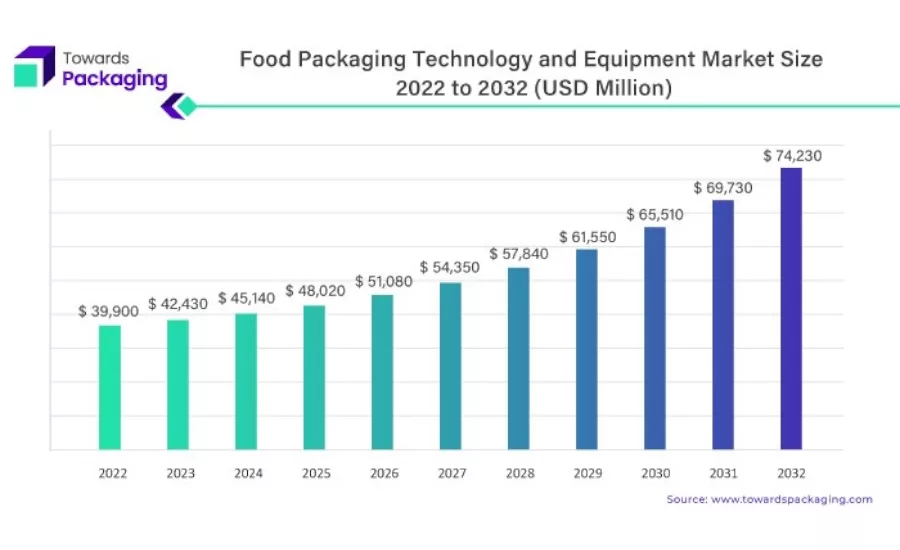Market Research
Food Packaging Technology and Equipment Market Size to Reach $74,230 Million By 2032

Image courtesy of Towards Packaging
Towards Packaging has revealed its latest report on the food packaging technology and equipment market.
According to the report, the global food packaging technology and equipment market size is expected to surpass $61,550 million by 2029. The food packaging technology and equipment market refers to the industry that involves developing, producing, and distributing technology and machinery used in packaging food products. This market plays a role in ensuring food items' safety, quality and preservation from the point of production to the end of consumption.
The global packaging sector has experienced consistent expansion, driven by an annual average growth of 25% in cross-border e-commerce transactions. This surge is attributed to exploring new markets and the increasing prosperity of the global middle-income demographic. This intricate interplay of elements underscores the importance of the food packaging technology and equipment market in facilitating food products' movement from production facilities to consumers, ultimately ensuring that these items meet the safety standards, quality and environmental responsibility, the report states.
Within the food packaging technology and equipment market, regional dynamics emerge as a defining factor, shaped by a confluence of economic, technological, and consumer-centric considerations. According to the report, North America stands prominently as a leading region in this dynamic market, its pre-eminence underpinned by a combination of factors that collectively contribute to its robust market position.
Stringent regulatory frameworks further elevate North America's status within the food packaging technology and equipment market. Regulatory measures designed to ensure the safety and integrity of packaged food products foster an environment where adherence to high-quality standards is imperative. The rigorous regulatory landscape compels industry players to invest in state-of-the-art packaging technologies and equipment that comply with existing standards and position North American products as exemplars of safety and quality on the global stage.
Its dedication to technological innovation further fortifies the European market's influence, says the report. A hotbed of research and development, Europe continually pushes the boundaries of food packaging technology, setting benchmarks for the global industry. Investments in cutting-edge technologies, including advancements in intelligent packaging, active packaging, and materials science, position European companies at the forefront of innovation. This pursuit enhances the efficiency of food packaging processes and ensures that European products meet safety, quality and traceability standards.
Advancements in Material Trends for Food Packaging
The tides of industry preference are undergoing a shift, fueled by an escalating global consciousness toward environmental sustainability. In response to mounting environmental concerns, there is a surge in the exploration and adoption of sustainable alternatives, marking a departure from the conventional reliance on plastic. Biodegradable plastics, heralded for their capacity to disintegrate naturally and reduce environmental impact, have gained traction as a substitute. This shift reflects an effort within the industry to mitigate the ecological footprint associated with traditional plastic packaging.
Furthermore, a rising momentum favors paper-based packaging, gaining prominence for its biodegradability and recyclability. Paper, a renewable resource, aligns with the growing consumer preference for eco-friendly packaging solutions, providing an alternative to mitigate concerns associated with non-biodegradable materials. The versatility of paper in accommodating various printing techniques for branding and information purposes adds an extra layer of appeal for manufacturers and consumers.
Developments in Active and Smart Technologies Transforming Food Packaging Technology
Simultaneously, the emergence of intelligent packaging technologies represents a paradigm shift in how food products are monitored and managed throughout the supply chain. Notable components of innovative packaging include QR codes, Near Field Communication (NFC) and sensors. Ubiquitous in retail, QR codes now find application in food packaging by providing consumers instant access to comprehensive product information. This includes details about the product's origin, ingredients, nutritional facts and interactive content. NFC technology, facilitating communication between devices in proximity, enhances traceability by allowing consumers to engage with products through their smartphones. These technologies contribute to greater transparency in the supply chain, enabling consumers to make informed choices about the products they purchase. Retailers of food estimate that 31% of food products are thrown out because they decay, resulting in losses of $146 billion. In the case of counterfeit products, innovative packaging might help prevent losses exceeding $460 billion.
Sensors embedded in intelligent packaging play a critical role in real-time monitoring, offering a proactive approach to quality and safety assurance. These sensors can measure and transmit data on various parameters such as temperature, humidity, and freshness. For example, in the perishable goods sector, temperature sensors ensure that the cold chain is maintained, preventing spoilage and preserving the integrity of the products from production to consumption. Real-time monitoring facilitated by these sensors enhances supply chain efficiency and enables swift responses to deviations from optimal storage conditions, minimizing compromised products reaching consumers.
The advancements in food packaging technology, particularly in active and intelligent packaging technologies, signify a transformative era for the industry. These innovations address product shelf life and quality challenges and pave the way for a more transparent and consumer-centric food supply chain. As technology continues to evolve, integrating these solutions is poised to become increasingly sophisticated, further elevating the standards of safety, quality, and efficiency in the food packaging sector.
Revolutionizing Packaging Efficiency with Vertical Form Fill and Seal Machines
Vertical Form Fill and Seal (VFFS) packaging machines have become indispensable across diverse industries, and their widespread adoption is rooted in their efficiency and cost-effectiveness. These machines prove to be packaging solutions, maximizing the utilization of limited factory floor space.
Looking for a reprint of this article?
From high-res PDFs to custom plaques, order your copy today!








